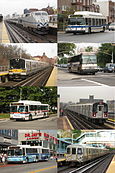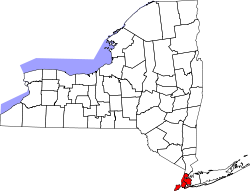- New York City Transit Police
-
New York City Transit Police Department Patch of the New York City Transit Police Department. Shield of the New York City Transit Police Agency overview Formed 1953 Dissolved 1995 Superseding agency New York City Police Department Legal personality Governmental: Government agency Jurisdictional structure Operations jurisdiction* City of New York in the state of New York, USA Map of New York City Transit Police Department's jurisdiction. Size 1,214.4 km² Population 8,274,527 Legal jurisdiction New York City General nature Specialist jurisdiction Commuter transit systems and immediate environs, rail, tram, ferry, bus, etc. Operational structure Police Officers Approx. 4000 Footnotes * Divisional agency: Division of the country, over which the agency has usual operational jurisdiction. The New York City Transit Police Department was a law enforcement agency in New York City that existed from 1953 (with the creation of the New York City Transit Authority) to 1995. The roots of this organization go back to 1936 when Mayor Fiorello H. La Guardia authorized the hiring of Special Patrolmen for the New York City Subway system. These patrolmen eventually became officers of the Transit Police.[1] In 1949, the department was officially divorced from the New York City Police Department, but was eventually fully re-integrated in 1995 as the Transit Bureau of the New York City Police Department by New York City Mayor Rudolph W. Giuliani.
In 1997, the Transit Bureau became the Transit Division within the newly formed Transportation Bureau. In July 1999, the Transit Division once again became the Transit Bureau, but remained part of the Police Department. Headquarters for the NYPD Transit Bureau are located at 130 Livingston Street in Brooklyn Heights.[2]
Contents
History
Rapid transit has played an integral part in the lives of New Yorkers for well over 100 years. The first trains ran at grade level and on elevated structures. Underground trains were added on October 27, 1904 when, after taking four and a half years to build, the Interborough Rapid Transit (IRT) opened to the public. Since both the IRT and the competing BMT (Brooklyn-Manhattan Transit) lines were privately financed and built, they had no police, but only their own private security personnel. The new IND (Independent) lines, however, which began operating in 1932, were owned by New York City and run by the Board of Transportation. These lines originally had "station supervisors" employed to police them, their names having been taken from the NYC Police Department's hiring list.
On November 17, 1933, six men were sworn in as New York State Railway Police. They were unarmed but were still responsible for the safety of the passengers on the IND line as well as guarding the system's property. Two years later, 20 "station supervisors, class B" were added for police duty. Responsible for assisting in the opening and closing of doors and announcing destinations, these 26 "specials" were soon given powers of arrest, but only on the IND line. And thus the New York City Transit Police Department was born.
In 1937, 160 more men were added to this police force. Additionally, 3 lieutenants, 1 captain, and 1 inspector from the NYPD were assigned as supervisors. When the privately-run IRT and BMT lines were taken over by New York City in 1940, the small patrol force on the IND line nearly doubled in size. Now part of the Civil Service system, more Transit supervisors were needed. In 1942, the first promotional exam was given for the title of "Special Patrolman Grade 2" – or what is now known as a sergeant.
The Code of Criminal Procedure was changed in 1947 granting Transit patrolmen peace officer status and by 1950, the number of "specials" reached 563. The following year, exams were held for both Transit sergeants and lieutenants. In 1953, the New York City Transit Authority came into being and assumed control over all the subway lines from the old Board of Transportation.
Beginning in 1949, the question as to who should supervise the Transit Police Department was one which was carefully scrutinized over the next five years by various city officials. The issue being considered was, "Should Transit be taken over by the NYPD?" In 1955, the decision was made that the Transit Police Department would become a separate and distinctly different Department, ending almost two decades of rule by the NYPD. The Civil Service Commission established a new test for Transit recruits, and on April 4, the first appointments from the list were made. An NYPD lieutenant, Thomas O'Rourke, was also designated the first commanding officer of the Transit Police Department. Soon after, Lieutenant O'Rourke along with 9 others, passed the captain's exam. Captain O'Rourke was then appointed as the first Chief of the new department.
With crime on the rise, the number of Transit officers increased so that by 1966, the Department had grown to 2,272 officers. That year, Robert H. Rapp was appointed Chief by the NYC Transit Authority. Under Chief Rapp, and at the direction of the Mayor, an ambitious new anti-crime program got underway. The program had a goal of assigning an officer to each of New York City's subway trains between the hours of 8:00 PM and 4:00 AM. And the Transit Police Department continued to grow. By early 1975, the department comprised nearly 3,600 members.
In 1975, a former NYPD chief inspector and sometime City Council president, Sanford Garelik, was appointed Chief of the Transit Police Department.[3] Determined to reorganize the Transit Police Department, Chief Garelik was also successful in instilling a new sense of pride and professionalism among the ranks. However, the fiscal crisis that began that year was an unexpected blow – especially to Transit cops. Over the next five years, layoffs and attrition would reduce their numbers to fewer than 2,800. New officers would not be hired until 1980. By the early 1990s however, the Transit Police Department had regained all of its former strength and had increased even further.
In 1991 the Transit Police gained national accreditation under Chief William Bratton. The Department became one of only 175 law-enforcement agencies in the country and only the second in the New York State to achieve that distinction. The following year it was also accredited by the State of New York, and by 1994, there were almost 4,500 uniformed and civilian members of the Department, making it the sixth largest police force in the United States.
Over time, however, the separation between the NYPD and the NYC Transit Police Department created more and more problems. Redundancy of units, difficulty in communications and differences in procedures all created frustration and inefficiency. As part of his mayoral campaign, candidate Rudolph Giuliani pledged to end the long unresolved discussion and merge all three of New York City's police departments (the NYPD, the Transit Police, and the NYC Housing Authority Police Department) into a single, coordinated force. Mayor Giuliani took office on January 1, 1994, and immediately appointed William Bratton as NYPD Police Commissioner whose great expertise at police work undertook the mission to fulfill Giuliani's promise and end a problem that had defied final solution for almost half a century. Discussions between the City and the New York City Transit Authority produced a memorandum of understanding, and on April 2, 1995, the NYC Transit Police was consolidated with the New York City Police Department to become a new Bureau within the NYPD. After a reorganization of the Department in February 1997, the Transit Bureau became the Transit Division within the newly formed Transportation Bureau. In July 1999, the Transit Division once again became the Transit Bureau.
Jobs of the transit police
One main task of the Transit Police was its defense of the subway system from defacement. Graffiti was very prominent throughout the subway system by the mid-1980s and the city government took a hard line in response, though some saw it instead as a "social trend" and a sign of diversity. The Transit Police, and specifically a new unit called the Vandal Squad began to fine and arrest those painting graffiti. Founded in 1980, the Vandal Squad’s mission was to protect the subway system from serious criminal acts of destruction like kicking out windows and throwing seats out of train cars. It was only with the Clean Car Program of 1984 that graffiti became the primary focus of this specialized Unit. They also made a policy to remove any work of graffiti within 24 hours of its creation. By the end of the 1980s, the Transit Police had effectively solved the problem of graffiti in the subway system.[4]
Fallen officers
During the existence of the New York City Transit Police Department, 13 officers died in the line of duty.[5]
Officer Date of Death Details Patrolman John Tuohy Wednesday, March 20, 1963 Heart attack Patrolman Lloyd Innes Friday, June 16, 1967 Gunfire Patrolman Michael Melchiona Saturday, February 28, 1970 Gunfire Police Officer John Skagen Wednesday, June 28, 1972 Gunfire (Accidental) Police Officer Sidney L. Thompson Tuesday, June 5, 1973 Gunfire Detective George Caccavale Saturday, June 26, 1976 Gunfire Police Officer Carlos King Monday, December 20, 1976 Gunfire Police Officer Seraphin Calabrese Sunday, February 24, 1980 Gunfire Police Officer Irving W. Smith Friday, February 29, 1980 Gunfire Police Officer Joseph Keegan Thursday, June 19, 1980 Gunfire Police Officer Joseph Hamperian Thursday, September 22, 1983 Struck by vehicle Police Officer Irma Lozada Friday, September 21, 1984 Gunfire Police Officer Robert Venable Tuesday, September 22, 1987 Gunfire See also
- List of law enforcement agencies in New York
- Amtrak Police Department
- Utah Transit Authority Police Department
- BART Police
- British Transport Police
- South Coast British Columbia Transportation Authority Police Service
- New Jersey Transit Police Department
- New York Metropolitan Transportation Authority Police Department
- Port Authority of New York & New Jersey Police Department
- Transit police
- Transportation in New York City
References
- ^ New York City Police Museum site Accessed January 26, 2008
- ^ New York City Government, 2002, Accessed August 29, 2007.
- ^ "Sanford Garelik, Former Mayoral Candidate, Dies at 93". New York Times. 2011-11-20. http://www.nytimes.com/2011/11/21/nyregion/sanford-garelik-former-new-york-city-mayoral-candidate-dies-at-93.html?_r=1. Retrieved 2011-11-23.
- ^ New York City Police Department, 2002, Accessed August 29, 2007.
- ^ The Officer Down Memorial Page Accessed January 26, 2008
External links
 External videos
External videos
NYPD Transit District 23 Dedication 9/18/2009, Metropolitan Transportation Authority; January 12, 2010; 1:31 YouTube video clip Metropolitan Transportation Authority of the State of New York Bus 
Rapid transit Commuter rail Crossings MTA Bridges and TunnelsLaw enforcement Fleet Other Bus and subway fares • MetroCard • New York City Transit Authority • Manhattan and Bronx Surface Transit Operating Authority • History of the New York City Subway • New York City Transit Police • MTA Capital ConstructionNew York City History · Neighborhoods · Architecture · Skyscrapers · Tourism · Attractions · Culture · Books · Arts · Parks · Cuisine · Dialect · People · Music · Sports · Media · Economy · Companies · Education · Schools · Government · Mayor · Central Park · Council · Fire · Police · Landmarks · Crime · Elections · Geography · Harbor · Gardens · Flag · Environment · Demographics · Enclaves · Transportation · Hospitals · Lists · Images · Portal Categories:
Categories:- Defunct law enforcement agencies of New York
- Specialist law enforcement agencies
- 1933 establishments
- 1995 disestablishments
- History of New York City
- Transit police departments of the United States
Wikimedia Foundation. 2010.



